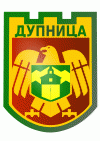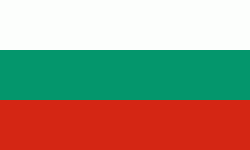Dupnitsa (Obshtina Dupnitsa)
 |
The town has existed since ancient times. The German traveller Arnold von Harff visited Dupnitsa in 1499 and described it as a "beautiful town". The names Tobinitsa, Doupla and Dubnitsa are mentioned throughout history, the last one used until the Liberation of Bulgaria, when the official name was changed to Dupnitsa. In 1948 the town was renamed Stanke Dimitrov; for a short period in 1949 it was called Marek; the name was changed to Stanke Dimitrov in 1950. After the democratic changes, the old name Dupnitsa was restored.
On 15 October 1902, around 600 women and children fled to the vicinity of Dupnitsa from Macedonia from the attacking Turkish troops.
On a hill overlooking the town there is a giant cross, commemorating the Bulgarians who perished in the Balkan wars and World War I. On the same hill there lay the ruins of a medieval fortress.
During World War II over 4,000 Jews from parts of Greece and Yugoslavia annexed by Bulgaria were arrested on 4 March 1943 and deported, some to an internment camp in Dupnitsa. Many of them were from Komotini and Xanthi. After 11 to 12 days in the Dupnitsa camp, on 18 – 19 March they were transferred by train to Lom on the Danube for extermination at Treblinka. As part of the Bulgarian Commissariat for Jewish Affairs's policy of deporting Jews, Dupnitsa also was between June 1943 and September 1944 the site of a ghetto for 1,624 Jews expelled from Sofia, even though there was ultimately no exterminations of Jews resident within Bulgaria's pre-war borders.
Nowadays Dupnitsa is a fast-developing town combining new buildings with modern architecture with its historical monuments. Because of its beautiful location at the foot of the Rila mountain, the town is marvelous holiday destination. One of the main branches of industry is the pharmaceutical company Actavis (formerly HeFeKa, in Bulgarian ХФК), which gives employment to about 30 to 40 percent of the citizens. Small business is developing rapidly due to the town's economic growth.
Dupnitsa is famous for its cultural festivals. From 1 May to 2 June many festivals are held in the town due to the richness of the Bulgarian holiday calendar. The nightlife is very well developed. There are a lot of local pubs and clubs where young people meet and have fun. A few other popular places for socializing are the recently refurbished Town Park and the Town Garden (Градска градина, Gradska gradina).
In recent years the town has become notorious due to the activities of an organised crime group led by pair of Bulgarian gangsters, former policemen Angel Hristov and Plamen Galev, known as the "Galevi brothers". Using intimidation and extortion, and with the help of corrupt policemen, they controlled Dupnitsa to the extent that they have been described as "the owners of the first private town in Bulgaria". Hristov and Galev are fugitives after having been sentenced to five and four years respectively but are still believed to control the town.
Map - Dupnitsa (Obshtina Dupnitsa)
Map
Country - Bulgaria
 |
 |
| Flag of Bulgaria | |
One of the earliest societies in the lands of modern-day Bulgaria was the Neolithic Karanovo culture, which dates back to 6,500 BC. In the 6th to 3rd century BC the region was a battleground for ancient Thracians, Persians, Celts and Macedonians; stability came when the Roman Empire conquered the region in AD 45. After the Roman state splintered, tribal invasions in the region resumed. Around the 6th century, these territories were settled by the early Slavs. The Bulgars, led by Asparuh, attacked from the lands of Old Great Bulgaria and permanently invaded the Balkans in the late 7th century. They established the First Bulgarian Empire, victoriously recognised by treaty in 681 AD by the Eastern Roman Empire. It dominated most of the Balkans and significantly influenced Slavic cultures by developing the Cyrillic script. The First Bulgarian Empire lasted until the early 11th century, when Byzantine emperor Basil II conquered and dismantled it. A successful Bulgarian revolt in 1185 established a Second Bulgarian Empire, which reached its apex under Ivan Asen II (1218–1241). After numerous exhausting wars and feudal strife, the empire disintegrated and in 1396 fell under Ottoman rule for nearly five centuries.
Currency / Language
| ISO | Currency | Symbol | Significant figures |
|---|---|---|---|
| BGN | Bulgarian lev | лв | 2 |
| ISO | Language |
|---|---|
| BG | Bulgarian language |
| TR | Turkish language |
















